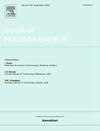基于RISMC和变压器代理模型的核电厂混合风险评估与预测方法
IF 2.3
3区 工程技术
Q1 NUCLEAR SCIENCE & TECHNOLOGY
引用次数: 0
摘要
核电站的安全运行对关键参数的准确预测和风险评估提出了严格的要求,特别是在复杂的运行工况和事故场景下,关键参数的动态演变直接影响着运行人员的态势感知和决策。本研究提出了一种基于RISMC (risk -informed Safety Margin Characterization)方法的混合风险评估与预测方法,将高保真的热液仿真与基于变压器的代理模型相结合,极大地扩展了RISMC在核电厂运行场景中的应用。该方法将时间序列预测与回归模型相结合,能够高精度预测蒸汽发生器水位、压力等关键参数的动态演变,同时动态量化各种干预策略对反应堆停堆风险的影响。该方法有效地解决了现有风险评估方法在电厂运行过程中计算效率和性能方面的挑战。以部分给水损失(PLOFW)情景为例,验证了该方法在动态预测、风险量化和干预策略评估方面的有效性。结果表明,该方法在预测精度和计算效率上有显著提高。该方法通过精确量化动态安全裕度,显著提高了作业者在异常事件和突发事件中的态势感知和决策能力,为优化干预策略提供了依据。这种方法既保证了核电站的安全灵活运行,又平衡了安全性和经济性。本文章由计算机程序翻译,如有差异,请以英文原文为准。
Hybrid risk evaluation and prediction method for nuclear power plant using RISMC and transformer-based surrogate model
The safe operation of nuclear power plants imposes strict requirements on the accurate prediction of key parameters and risk assessment, particularly under complex operating conditions and accident scenarios, where the dynamic evolution of key parameters directly impacts operators’ situational awareness and decision-making. This study proposes a hybrid risk evaluation and prediction method based on Risk-informed Safety Margin Characterization(RISMC) methodology, integrating high-fidelity thermal–hydraulic simulation with a Transformer-based surrogate model, significantly expanding the application of RISMC to the operation scenario of nuclear power plants. By combining time-series prediction with regression models, the proposed method enables high-accuracy prediction of the dynamic evolution of critical parameters, such as steam generator water level and pressure, while dynamically quantifying the impact of various intervention strategies on reactor shutdown risk. This approach effectively addresses the challenges of existing risk assessment methods in computational efficiency and performance during plant operation. A Partial Loss-of-Feedwater (PLOFW) scenario is used as a case study to verify the method’s effectiveness in dynamic prediction, risk quantification, and intervention strategy evaluation. The results demonstrate that the proposed method significantly outperforms prediction accuracy and computational efficiency. By precisely quantifying dynamic safety margin, the method significantly enhances operators’ situational awareness and decision-making capabilities during abnormal events and incidents, providing a basis for optimizing intervention strategies. This approach not only ensures the safe and flexible operation of nuclear power plants but also balances safety and economic efficiency.
求助全文
通过发布文献求助,成功后即可免费获取论文全文。
去求助
来源期刊

Annals of Nuclear Energy
工程技术-核科学技术
CiteScore
4.30
自引率
21.10%
发文量
632
审稿时长
7.3 months
期刊介绍:
Annals of Nuclear Energy provides an international medium for the communication of original research, ideas and developments in all areas of the field of nuclear energy science and technology. Its scope embraces nuclear fuel reserves, fuel cycles and cost, materials, processing, system and component technology (fission only), design and optimization, direct conversion of nuclear energy sources, environmental control, reactor physics, heat transfer and fluid dynamics, structural analysis, fuel management, future developments, nuclear fuel and safety, nuclear aerosol, neutron physics, computer technology (both software and hardware), risk assessment, radioactive waste disposal and reactor thermal hydraulics. Papers submitted to Annals need to demonstrate a clear link to nuclear power generation/nuclear engineering. Papers which deal with pure nuclear physics, pure health physics, imaging, or attenuation and shielding properties of concretes and various geological materials are not within the scope of the journal. Also, papers that deal with policy or economics are not within the scope of the journal.
 求助内容:
求助内容: 应助结果提醒方式:
应助结果提醒方式:


